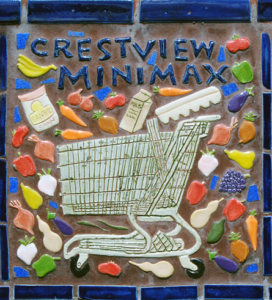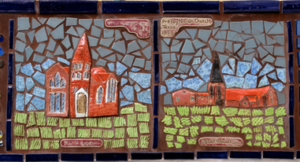Copyright 2022 Susan Burneson. All rights reserved. Kindly talk with us before reproducing any website content. (What’s a WABAC Machine? Find out here.)
2021 • COVID, URI . . . AND SO MUCH MORE, JANUARY–MAY
The COVID-19 pandemic continued into its second year. As the year went on, vaccinations and boosters became available and the number of cases began dropping, and the world began to feel more open and hopeful. Then, around Thanksgiving, news of the highly transmissible Omicron variant of COVID-19 emerged. The number of COVID cases skyrocketed as 2021 came to an end.
Nevertheless, neighbors in Brentwood and Crestview carried on, celebrated, and thrived. (We also remember special neighbors—Chris Lippincott and Kyle Gillman among them—who passed away in 2021, much too soon.) Local schools, churches, businesses, and events operated more normally but not without ongoing challenges. While the spring Violet Crown Festival was cancelled for the second year, the fall National Night Out, two Oktoberfests, and Halloween, and winter luminarias went on as usual, or close to it.
Below are a few other highlights of the year just past, beginning with January through May.
JANUARY
January 3 • The local Being Neighborly Facebook group was expanded to include Brentwood and Crestview. Now it’s called Being Neighborly North Central Austin and also includes Wooten, North Shoal Creek, Allandale, and North Austin. Similar groups include Buy Nothing and Waste Nothing—Allandale/Crestview/Shoal Creek/Wooten.
FEBRUARY
Mid-February • Winter Storm Uri hit Texas, affecting many neighbors in Brentwood and Crestview.
First, a few statistics: In Austin, more than 6 inches of snow and ice and record-breaking cold (as low as 6 degrees on February 16 and below freezing for 6 days straight), and more than 200,000 households lost power to their homes for varying amounts of time. The storm caused more than $195 billion in damage in Texas, making it the costliest natural disaster in the state’s history. And, at least 246 Texans died as a result of the storm, 28 of them in Travis County, according to a final report released in December 2021 by the Texas Department of State Health Services.
 Austin Energy announced in the early morning hours of February 15 that some customers would begin having “rolling blackouts” to help conserve electricity. Like many other Austinites, we woke the next morning to a quiet, chilly house. Our electricity didn’t “roll” once it went off, and we had no idea when it would come back on.
Austin Energy announced in the early morning hours of February 15 that some customers would begin having “rolling blackouts” to help conserve electricity. Like many other Austinites, we woke the next morning to a quiet, chilly house. Our electricity didn’t “roll” once it went off, and we had no idea when it would come back on.
With frigid temperatures outside, the temperature inside our house fell to the mid-40s. We were fortunate to have natural gas, running water, and lots of heavy clothes and blankets. We had a car where we could get warm and charge our cell phones, so we could stay in touch with neighbors and with friends and family outside Austin.
Our local Buy Nothing group provides a popular way for neighbors to offer and to ask for free items and services. During the storm, BN groups became a lifeline for many, as highlighted in a Texas Standard online article, “When Power and Water Failed ‘Buy Nothing’ Groups Helped Fill the Gaps.” One woman posted on our BN group that she woke up in her poorly insulated bedroom with ice crystals on her eyelashes. Another said she was concerned about her frail cat in such a cold house. Neighbors offered them and others warm places to stay. Some offered to charge phones, give rides and run errands in their four-wheel-drive cars, provide hot food and drinks, share words of support and the latest news updates, or simply listen (as my neighbor Jennipher Judge kindly did).
With most businesses closed during the height of the storm, we felt hopeful as we discovered, one-by-one, that a nearby gas station, local small grocery Dia’s Market, comfort-food-hub Tiny Pies, and our favorite large grocery HEB had reopened. The New York Times featured HEB in its February 22 article “Texans Needed Food and Comfort After a Brutal Storm. As Usual, They Found It at H-E-B.”
Our electricity was out for 48 hours. It came back on again without notice very early in the morning. After that, we took a 5-day boil order for our water in stride. And, we were fortunate that the city was able to quickly trim back frozen tree limbs pressing on our newly restored power lines. Other neighbors were without electricity, gas, and/or running water for a much longer time.
A November 21 City of Austin audit concluded that the city was unprepared for the storm and had not followed earlier recommendations for such an event. According to a December 2021 article in Community Impact, ERCOT, the state’s electric grid manager, “acknowledges that power loss is once again a possibility” and that “officials . . . urge personal prep,” if the state is faced with a similar storm.
More than a step ahead of both, during the storm neighbors began sharing lists of what to keep on hand in a similar emergency, based on their experiences. One list posted on the Being Neighborly North Central Austin group continues to be updated.
A few items on my list—a weather radio that worked, extra batteries for flashlight and radio, candles and starters/matches, wool socks, leg warmers, something to melt ice on sidewalks, water jug with spigot, boots, charger bricks and cables, ready-to-eat and easy-to-heat food, drinking water, long underwear, and thermometers for refrigerator and freezer.
A common saying about Texas weather is “Mother Nature says: ‘You can’t squeeze all the weather in the world into one week.’ Texas says: ‘Hold my beer and watch this.'” Within a week of the record-shattering 6-degree cold, in Austin all the snow and ice were long gone and the temperature climbed to 76 degrees.
MARCH
 March 6 • Arlan’s, the grocery store that replaced Crestview Minimax IGA (right, on the mosaic Wall of Welcome) at the Crestview Shopping Center in February 2016, was sold to Fresh Plus, which now occupies the space there.
March 6 • Arlan’s, the grocery store that replaced Crestview Minimax IGA (right, on the mosaic Wall of Welcome) at the Crestview Shopping Center in February 2016, was sold to Fresh Plus, which now occupies the space there.
March 22 • The Historic Landmark Commission released a demolition permit for First Cumberland Presbyterian Church (below, also on the mosaic wall) in Brentwood. The church was founded in downtown Austin in 1846 and moved to its Woodrow Avenue location in 1956. According to an August 2021 Austin Business Journal article the new owner plans to build new attached and detached homes on the 1.5-acre site. (The church was demolished in January 2022.)
April 7 • Over the spring, six students in Laura Beck’s fifth-grade class at Brentwood Elementary tackled an ambitious project—to learn more about the history of their school and neighborhood. Laura asked if I could offer any ideas that might help. I shared links to neighborhood history on the Voices of the Violet Crown website and other information I thought might pique their interest. The students took it from there. They researched their neighborhood and school, interviewed students, and created a unique, informative, and inspiring presentation. They shared it first with their class. During the last week of school, then-principal Amber Laroche included their presentation in the weekly announcements shared with all the students.
MAY
While its spring Violet Crown Festival was cancelled this year because of the ongoing pandemic, Violet Crown Community Works held its fourth annual Oktoberfest in Brentwood Park on October 24.

